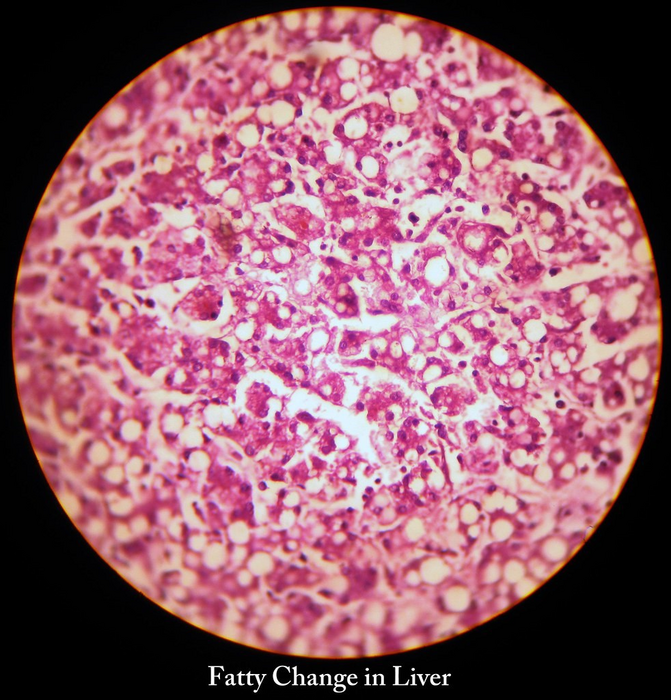It is a known fact that consuming a large amount of alcohol, even for a few days, triggers fat accumulation in the liver and ultimately leads to alcohol-related liver diseases. On the contrary, when fat accumulation occurs in the liver even in the absence of alcohol consumption, the condition is termed non-alcoholic fatty liver disease (NAFLD). NAFLD is a potentially serious chronic liver disease affecting approximately 25% of adults worldwide. Patients with NAFLD are 33% more likely to suffer from coronary heart disease when compared with healthy controls.

Credit: Albaraa Mehdar
It is a known fact that consuming a large amount of alcohol, even for a few days, triggers fat accumulation in the liver and ultimately leads to alcohol-related liver diseases. On the contrary, when fat accumulation occurs in the liver even in the absence of alcohol consumption, the condition is termed non-alcoholic fatty liver disease (NAFLD). NAFLD is a potentially serious chronic liver disease affecting approximately 25% of adults worldwide. Patients with NAFLD are 33% more likely to suffer from coronary heart disease when compared with healthy controls.
Although it is a serious and chronic liver ailment that is closely related to multiple other diseases, the underlying mechanisms associated with NAFLD remain more or less elusive. To this end, researchers from China recently conducted a meticulous literature survey and composed a review based on their findings. Their article has been published in Chinese Medical Journal on 06 July 2022.
Dr. Chengfu Xu, corresponding author of the paper and a principal investigator at the Zhejiang University School of Medicine, China, observes, “In recent years, the prevalence of NAFLD-associated hepatocellular carcinoma has shown an increasing trend in many countries. The proportion of hepatocellular carcinoma attributed to NAFLD tripled from 3.8% in 2001–2005 to 12.2% in 2006–2010 in Korea. Similarly, this proportion increased from 2.6% in 1995–1999 to 19.5% in 2010–2014 in France. Therefore, NAFLD poses a substantial burden on global health resources and the economy.”
Retinol, or vitamin A, is a fat-soluble vitamin that is primarily stored in the liver and transported to other organs by binding to retinol-binding protein-4 (RBP4). In the target organs (e.g., eyes), retinol can be taken up by the binding of RBP4 to cell membrane receptors. However, the role of RBP4 in the development of insulin resistance and obesity has received significant attention only in recent times.
Although multiple observational studies have also demonstrated the association of serum RBP4 with NAFLD risks, the results have shown several obvious contradictions. Emerging clinical studies are focusing attention on the role of RBP4 in NAFLD. In the review article, the researchers have presented a global overview of the RBP4 landscape and highlighted the most recent findings of clinical significance.
In the review, the authors cite multiple studies that are relevant to the problem under investigation. For example, they cite a 2005 publication in which researchers reported the association between elevated serum RBP4 levels and insulin resistance. Dr. Xu and his colleague also cite contradictory research findings. For instance, although a Turkish study reported higher levels of serum RBP4 in children who were obese and suffering from NAFLD, an Italian study found a negative correlation between serum RBP4 levels and NAFLD activity score in pediatric patients with NAFLD.
Dr. Xu explains, “These contradictory findings may result from the heterogeneity of fatty liver detection methods and study participant’s race, as well as the limited size of the study sample. The studies observing no significant association or inverse association between RBP4 level and NAFLD all diagnosed fatty liver by biopsy. Liver biopsy is the gold standard for the diagnosis of NAFLD. It is worth noting that none of these studies found a significant correlation between serum RBP4 level and body mass index, waist circumference, and fasting plasma glucose or insulin levels, although the correlation has been confirmed in a large body of studies.”
The review also sheds light on some of the associated physiological mechanisms. For instance, it is known that free RBP4 can be easily filtered in the kidneys because of its small molecular weight. However, transthyretin (TTR), a thyroid hormone carrier, binds RBP4 and prevents it from getting filtered. A therapeutic called fenretinide, however, dissociates RBP4 from TTR, thus facilitating the renal excretion of RBP4, thereby lowering the circulating levels of RBP4 in the process.
“First, clinical observations found that circulating RBP4 levels were closely associated with NAFLD risk, but discrepancies still exist. Second, basic studies have verified that RBP4 is involved in the pathogenesis of NAFLD by inducing hepatic de novo lipogenesis, impairing fatty acid oxidation, exaggerating insulin resistance, and promoting inflammation. Third, agents aimed at lowering circulating RBP4 levels and downregulating hepatic RBP4 expressions exerted protective effects against NAFLD. These findings raise the possibility of targeting RBP4 as a novel marker and a potential therapeutic target for NAFLD,” concludes Dr. Xu.
Let’s hope that the scientific community resolves the existing conflicts by designing well-controlled experiments and large-scale clinical trials. Meanwhile, kudos to the researchers for identifying the existing discrepancies and channelizing the research focus in the right direction.
***
Reference
DOI: https://doi.org/10.1097/CM9.0000000000002135
Journal
Chinese Medical Journal
DOI
10.1097/CM9.0000000000002135
Method of Research
Literature review
Subject of Research
Not applicable
Article Title
Retinol-binding protein-4 and nonalcoholic fatty liver disease
Article Publication Date
6-Jul-2022
COI Statement
The authors declare no conflict of interest.




